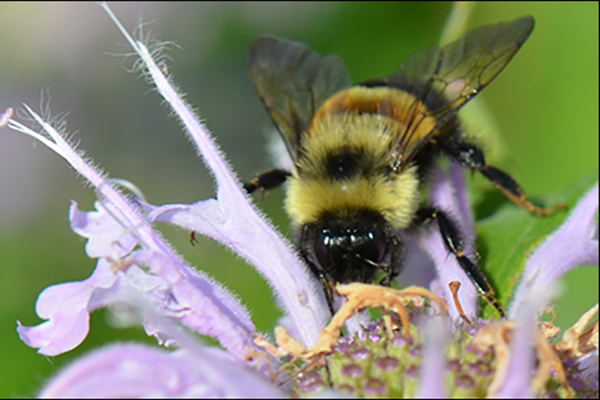Rusty Patched Bumble Bee
Bombus affinis
Cool Fact: Bumble bee queens hatch in the fall and spend the winter a few inches below the snow.

Photo by Kim Mitchell/USFWS
In the shortening days of late August and September, the bumble bees are ever-present in the garden. Deliberate in their flight, they hover and land on the oregano, arugula, butterflyweed, sunflower, hosta. They climb over blossoms and disappear into petals, harvesting nectar and pollen. Flower stems bend with their weight.
These are female “worker bees,” toiling since June in service of the whole, and younger males looking for a mate. Their queen is in her nest, laying more eggs that will become the parents of the next generation.
In the garden, meadow, forest, apple orchard, and blueberry field, the bumble bees feed on nectar and collect pollen for the youth of their colony. In the process, they pollinate fruits and vegetables, giving more than they take.
For most people, the bumble bee does not instill the kind of fear as the honey bee, the yellowjacket, the wasp. Large and fuzzy, they are always seen and heard before they are felt, if they are felt at all. They only sting if pinched or threatened. And so they permit up-close observation. Most are striped black and yellow, some with a black smudge between the wings. Others have two orange stripes in the middle or toward the back end, or a belt of brown. But rare is the species with a specific bit of orange amid the yellow.
Last seen in Stockton Springs nearly a decade ago, the rusty patched bumble bee (Bombus affinis) is one of four bumble bees native to Maine that were once very common (the others being the American, the yellow-banded, and Ashton’s cuckoo bumble bee). Another 14 species live here, of some 46 in North America and 250 around the world.
Bees across the world have been on the decline, for reasons ranging from habitat loss to pollution to climate change. Honeybees get a lot of attention, although they are an immigrant species. The native rusty patched bumble bee ranges throughout the northeastern U.S., from North Dakota to Maine and south along the Applachian Mountains to Georgia. But the population has declined by more than 90 percent, prompting the federal government to officially list Bombus affinis as an endangered species in March 2017.
The rusty-patched prefers colder climates, as evidenced by its northerly and mountainous distribution. Drought or extended heat waves can wipe out a colony. But in terms of habitats and food sources, the rusty-patched is a generalist, living in a variety of landscapes including woods, marshes, farm fields, suburban parks, and gardens. This flexibility would seem to be a benefit, but it may instead be the source of the rusty-patched bumble bee’s downfall.
Their colonies are ephemeral, starting over each year with the emergence of a new solitary queen carrying fertilized eggs, which means they need an immediate, constant, and diverse supply of flowers in spring: serviceberry, plum, cherry, wild rose, milkweed, jewelweed, mountain mint, button bush. Unlike honey bees and butterflies, the bumblers fly and feed on cold and rainy days, so desperate are they for food and nutrition in the short summer season. Pollen supplies protein to growing larvae, while nectar provides energy for flight and some protein, too. Giant hyssop, coneflower, joe-pye weed, goldenrods, and New England aster are especially rich. Other plants, like wild bergamot and cranberry, support their immune systems. Declines in these latter plants could have made bumble bees more vulnerable to pathogens from managed bees. But more likely, it is their pursuit of food from any and all flowers that is behind the declines.
Many commercially sold flowers and garden plants as well as agricultural crops like soybeans and corn are treated with water-soluble pesticides that mimic nicotine, poison the central nervous system of insects, and persist in nectar, pollen, and soil. So-called “neonicotinoids” are ingredients in products to “control” aphids, beetles, fleas, flies, and cockroaches. Recent research suggests that the addictive qualities of pseudonicotine in these pesticides may be experienced by bees, who seek out treated flowers.
Application rates of this newer class of pesticides have increased over the same period that many bee species have declined. While scientists are normally hesitant to equate such correlation with causation, there is enough evidence of neonicotinoid toxicity on bumble bees to lead biologists to conclude that the pesticides have likely contributed to the loss of rusty-patched bumble bees.
Late in the season, the garden is quiet. The bumble bees are there, but no one is buzzing. The colony is disintegrating as males and potential queens are leaving the nest to mate; they sip the nectar but ignore the pollen. Soon, all will die except the newborn queens, who will hibernate a few inches beneath the snow. When they emerge from the ground next April, they will leave to find fresh flowers. As they fill their leg-baskets with pollen and lap the sun-filled nectar, will they also be collecting acetamiprid, clothianidin, dinotefuran, imidacloprid, nitenpyram, thiocloprid, thiamethoxam? Will anyone be watching, waiting to see if there’s a rusty patch between the yellow?
What can you do to help the rusty patched bumble bee and her kin? Don’t use or purchase pesticides or other yard and garden chemicals, plant native flowers, and participate in the Maine Bumble Bee Atlas.
Creature Feature by Catherine Schmitt, a science writer based in Bangor. Her most recent book is Historic Acadia National Park.










